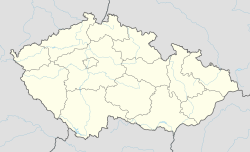Vyšní Lhoty
| Vyšní Lhoty | |||
|---|---|---|---|
| Village | |||

Saint Anthony of Padua Church on the Prašivá mountain
|
|||
|
|||
| Location in the Czech Republic | |||
| Coordinates: 49°38′1″N 18°28′21″E / 49.63361°N 18.47250°ECoordinates: 49°38′1″N 18°28′21″E / 49.63361°N 18.47250°E | |||
| Country | Czech Republic | ||
| Region | Moravian-Silesian | ||
| District | Frýdek-Místek | ||
| First mentioned | 1524(?), 1584 | ||
| Government | |||
| • Mayor | Dana Nováková | ||
| Area | |||
| • Total | 11.48 km2 (4.43 sq mi) | ||
| Elevation | 375 m (1,230 ft) | ||
| Population (2012) | |||
| • Total | 832 | ||
| • Density | 72/km2 (190/sq mi) | ||
| Postal code | 739 51 | ||
| Website | www |
||
Vyšní Lhoty (German: Ober Ellgoth, Polish: Ligota Górna) is a village in the Frýdek-Místek District, Moravian-Silesian Region of the Czech Republic. It has a population of 757 (2006).
It lies on the Morávka River, on the foothills of the Moravian-Silesian Beskids and the Prašivá mountain in the historical region of Těšín Silesia. There is a wooden Saint Anthony of Padua church from 1640 on the Prašivá mountain.
There is a refugee camp of the Ministry of Interior in the municipality. Students of Refugee Law Clinic of Centre for Clinical Legal Education (Palacký University, Faculty of Law) get clinical experience there by assisting in providing pro bono legal help there.
Some sources state that the village was first mentioned in a Latin document of Diocese of Wrocław called Liber fundationis episcopatus Vratislaviensis from around 1305 as item in Warmnuthowitz, however it is very unlikely and disputed.Moudreho Lhota mentioned in 1524 still leaves doubts. Surely it was mentioned in 1584 as Hornÿ Lhota in the document sealing the selling of Friedeck state country by Stanislaus Pavlovský von Pavlovitz, Bishop of Olomouc, to Bartholomew von Wrbno. The adjective Hornÿ (lit. Upper, later also Superiori, Ober, Górne, Vyšní) was used to differentiate it from the older sister settlement lying down Morávka river, called Dolny neb Spodny Lhota in the same document from 1584.
...
Wikipedia



